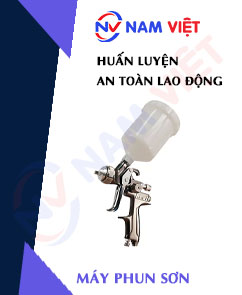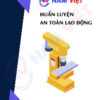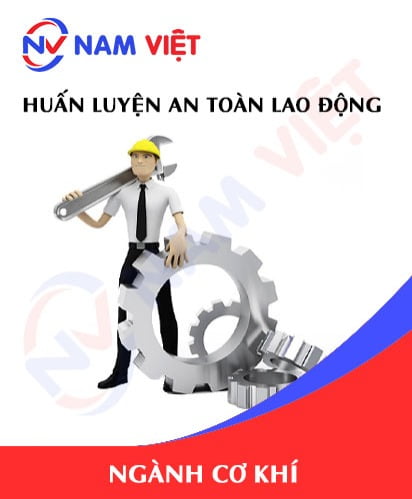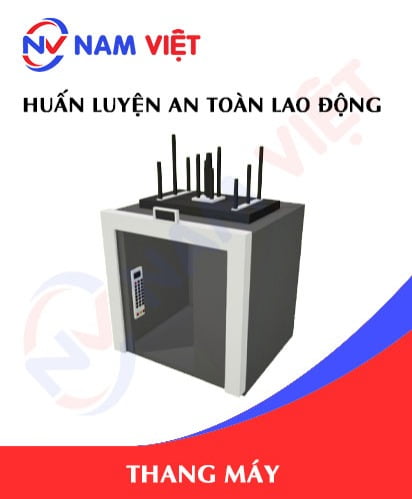Occupational Safety Training for Spray Painting Machine Operation
99,000 ₫
Note: The price above is calculated per person and may fluctuate depending on the number of participants in the course and market conditions. For more accurate pricing support, please refer to the price list or contact our consulting staff directly.
Occupational safety is an important issue when operating a paint sprayer and must be addressed promptly to ensure the health and safety of workers and enhance the reputation of businesses here. The Occupational Safety Training course is one of the effective solutions to raise awareness of how to prevent workplace accidents for workers operating a paint sprayer.
Table of Contents
Toggle1. Overview of Spray Painting Machines
a. What is an Airless Spray Machine?
An airless spray machine, also known as a non-air spray machine, is a device used to efficiently and quickly apply paint, anti-corrosion coatings, protective coatings, and other liquids onto surfaces. The airless spray machine operates by generating high pressure to push the coating through a very small nozzle, producing a relatively fine and even spray.
Key advantages of airless spray machines include:
- Speed and efficiency: This machine can spray paint faster than traditional methods such as brushes or rollers.
- Even coating: Airless spray machines create a fine, uniform spray, ensuring an even coating on surfaces.
- High pressure: The machine can spray paint at high pressure, allowing it to reach gaps and uneven surfaces easily.
- Paint savings: Due to the fine and uniform spray, airless spray machines save paint compared to traditional methods.

b. How the Spray Machine Works
The operation principle of an airless spray machine is based on using high pressure to apply paint smoothly and evenly on surfaces. Here’s an outline of how it works:
- Paint source: The spray machine is connected to a paint source, usually a paint can or container. Paint is delivered from the source to the machine via a hose.
- Pump: The machine is equipped with a powerful pump, typically a piston or cylinder pump. The pump generates high pressure to push the paint out.
- High pressure: The pump creates enough pressure to force the paint through the nozzle.
- Nozzle: The nozzle is a critical component. Paint passes through the nozzle and is dispersed into tiny droplets by the high pressure and nozzle shape. Nozzles are designed to produce a fine, even spray.
- Surface coating: As paint exits the nozzle, it is sprayed onto the target surface. High pressure allows the paint to reach gaps and provide a uniform layer.
- Adjusting pressure and flow: Airless spray machines usually allow adjustment of pressure and flow, enabling control of paint type, coating thickness, and spray speed.

c. Industries Using Spray Machines
Spray machines are widely used across various industries due to their efficiency, even coverage, and speed. Key industries include:
- Construction and interior decoration: Used for painting walls, ceilings, doors, windows, and furniture such as cabinets, chairs, and tables.
- Automotive and marine industries: Used for painting cars, ships, and other metal components.
- Wood and furniture industry: Used for coating wood surfaces in furniture and other wood products.
- Metal industry: Used to protect metals from corrosion or to apply anti-corrosion coatings.
- Construction industry: Used to coat concrete, steel, and other metal surfaces.
- Maintenance and repair: Used for repairing and maintaining buildings, bridges, and other infrastructures.
- Manufacturing industry: Used to coat products and components, from electronics to large industrial products.
2. Overview of Occupational Safety Training for Spray Machine Operation
a. What is Occupational Safety Training?
- Occupational safety training for spray machine operation equips workers with knowledge to prevent workplace accidents. Those directly operating spray machines belong to Group 3.
- Safety training helps workers recognize and avoid hazards, reducing the risk of accidents while working.
REGISTER FOR OCCUPATIONAL SAFETY TRAINING
b. Training Duration
Initial Safety Training:
- Total training time is at least 24 hours, including exams.
- 8 hours of theory on policies and labor safety laws
- 8 hours of theory on basic occupational safety knowledge
- 4 hours of theory on specialized training content
- 2 hours of practical training on specialized content
- 2 hours of final theory exam
Training centers may split the course into multiple sessions, usually 6 sessions over 3 days, depending on the company’s schedule.
Periodic Safety Training:
- Before the occupational safety card expires, workers must undergo periodic safety training, with training time at least 50% of the initial course.
Explanation: Total periodic training time is at least 12 hours, including exams. Upon completion and passing the test, the safety card will be renewed.
c. Training Content
| No. | TRAINING CONTENT | TRAINING HOURS | |||
| Total | Including | ||||
| Theory | Practice | Exam | |||
| I | Policies and labor safety laws | 8 | 8 | 0 | 0 |
| 1 | Overview of occupational safety legal documents. | 6 | 6 | ||
| 2 | Standards and technical regulations on occupational safety. | 1 | 1 | ||
| 3 | Specific regulations from state management agencies for new construction, expansion, or renovation, and handling equipment requiring strict safety standards. | 1 | 1 | ||
| II | Basic occupational safety knowledge | 8 | 8 | 0 | 0 |
| 1 | Basic knowledge of workplace hazards. | 4 | 4 | ||
| 2 | Methods to improve working conditions. | 1 | 1 | ||
| 3 | Safety culture in production and business. | 1 | 1 | ||
| 4 | Rights and obligations of employers and workers; labor safety policies; functions of safety staff network. | 1 | 1 | ||
| 5 | Safety regulations, signs, and use of protective equipment; first aid and occupational disease prevention skills. | 1 | 1 | ||
| III | Specialized training content | 6 | 4 | 2 | 0 |
| Comprehensive knowledge of machines, hazardous substances, risk assessment, safe work procedures, and safety management. | 6 | 4 | 2 | ||
| IV | Final safety exam | 2 | 2 | 0 | 0 |
| Total | 24 | 22 | 2 | ||
See more training content for all 6 groups
d. Occupational Safety Card
After completing the training and passing the exam, workers are issued an occupational safety card (commonly called Group 3 safety certificate).
The card includes personal information, job, working environment, training time, red seal, and signature confirming completion.
According to regulations in Clause 2 of Article 24, Decree 44/2016/ND-CP, there are 2 cases:
- If the employer and employee have a labor contract, the employer must sign and stamp the card after the employee completes training and passes the test.
- If the worker is freelance or temporary, training organization must sign and stamp the card after the worker completes the course and passes the test.

3. Hazards When Operating Spray Painting Machines
Operating a spray painting machine can pose several hazards to the operator and the surrounding environment. Here are some common hazards when using a spray painting machine:
- Risk of inhaling paint fumes: Paint fumes can be harmful if inhaled. Some paints contain dust particles and organic vapors that may irritate the respiratory system and affect health. Operators should work in a well-ventilated environment, use protective equipment such as respirators, and comply with workplace safety regulations.
- Risk of paint contact: Paint can irritate the skin and eyes if contacted directly. Paint splashes may cause bleeding, swelling, infection, or irritation. Operators should wear protective clothing such as coveralls, gloves, goggles, and safety shoes.
- Fire and explosion risk: Spray painting machines often operate under high pressure and use paints containing flammable solvents. Failure to follow safety regulations for storage, usage, and operation may result in fire or explosion.
- Noise hazard: Spray painting machines generate high noise levels during operation. Prolonged exposure can harm hearing. Operators should use hearing protection such as earmuffs or earplugs.
- Environmental risk: Paint and dust particles from the spraying process can pollute the environment if not properly managed. Operators must follow regulations for waste handling and environmental protection.

4. Measures to Prevent Work Accidents When Operating Spray Painting Machines
To prevent work accidents while operating spray painting machines, multiple safety measures must be implemented. Key measures include:
- Training: Ensure operators are fully trained on machine usage, safety rules, and emergency procedures. This includes machine inspection, maintenance, choosing the appropriate paint, and proper use of protective equipment.
- Personal protection: Operators must wear complete personal protective equipment such as respirators, safety goggles, gloves, protective clothing, and safety shoes to protect against paint fumes and direct contact.
- Machine and equipment inspection: Check machines and connected equipment before use to ensure proper functioning and no defects.
- Operating in a well-ventilated environment: Use spray painting machines in areas with fans and proper airflow to reduce airborne paint fumes.
- Eliminating fire and explosion risks: Avoid using machines near flames or flammable environments, as paints and solvents are highly flammable.
- Proper waste handling: Dispose of paint and dust particles according to environmental regulations and guidelines.
- Use of safety devices: Ensure machines are equipped with safety devices like automatic shut-off sensors in case of inactivity or malfunction.
- Use safe paint: Select paints that are safe and non-toxic. Follow manufacturer instructions for usage and storage.
- Monitor pressure and flow: Regularly check paint pressure and flow to ensure compliance with regulations and prevent malfunctions.
- Periodic safety inspections: Conduct regular inspections of machines and personal protective equipment to ensure proper functioning.
- Periodic certification of spray painting machines to detect safety issues such as wear, mechanical faults, or damage, thereby reducing the risk of work accidents.
5. Benefits of Occupational Safety Training
An Toàn Nam Việt provides the following benefits for businesses after completing occupational safety training under Decree 44/2016/ND-CP on occupational safety and hygiene:
- Employees can identify potential workplace hazards and take preventive measures to avoid accidents.
- Businesses can establish risk prevention measures in production, operation, and maintenance processes.
- Reduce costs associated with workplace safety incidents.
- Maintain uninterrupted production to improve productivity and product quality.
- Ensure compliance with labor safety laws and reduce legal risks.
- Enhance professionalism and credibility, elevating the company’s brand.
Nam Việt’s training programs are designed to help individuals avoid external hazards that may lead to injury or, in severe cases, death.
REGISTER FOR OCCUPATIONAL SAFETY TRAINING
6. Customer Feedback After Completing Training
An Toàn Nam Việt has years of experience partnering with businesses across Vietnam, especially in the southern provinces. Our responsibility to these companies is highly valued, and therefore our occupational safety training has become increasingly professional. Positive feedback and suggestions from our partners have driven our growth. Below are some testimonials from companies we have served.
See more customer interviews after using our services from An Toàn Nam Việt
7. An Toàn Nam Việt’s Occupational Safety Training Capabilities
An Toàn Nam Việt is a leading center for high-quality occupational safety training in Vietnam. Our training sessions are conducted continuously at production facilities, factories, and construction sites nationwide (63 provinces).
REGISTER FOR OCCUPATIONAL SAFETY TRAINING
Occupational Safety Training Certification
- An Toàn Nam Việt has been inspected and certified by the Department of Safety under the Ministry of Labor – Invalids and Social Affairs for occupational safety and hygiene training, reinforcing our capability in occupational safety training.

Training Materials and Lectures
- All training materials undergo review and approval to ensure accuracy and effectiveness before being used in OST courses.
- Our instructors follow standardized teaching methods developed by An Toàn Nam Việt to maximize knowledge transfer effectiveness.
Facilities
- Managing classroom factors that affect training enhances teaching efficiency and knowledge absorption.
- Our training facilities include spacious classrooms meeting standards for area, lighting, and equipment.
8. Nationwide Reputable Occupational Safety Training Center
At An Toàn Nam Việt, we prioritize occupational safety training. Our mission is to equip workers with the knowledge to protect themselves, contributing to the country’s development.
To ensure training effectiveness, we carefully prepare tools, teaching materials, sound, and lighting. Our instructors are experts with years of experience and research on hazard identification across various industries.
Lectures are practical, engaging, and aligned with Decree 44/2016/ND-CP, enabling workers to learn preventive measures and apply them effectively on the job.
Our training center proudly offers professional, reliable occupational safety training with advantages including:
- Competitive training costs with ensured quality.
- Flexible scheduling to fit company production needs.
- Fast and compliant certification procedures.
- Experienced instructors.
- Classrooms optimized for learning efficiency.
- Lessons tailored to corporate safety requirements.
- Dedicated, professional support for customers.

9. Additional Occupational Safety Training Resources
- Occupational Safety Training Materials
- Occupational Safety Materials for Hand-Held Spray Machines
- Occupational Safety Training Tests
- Safety Quiz for Spray Painting Machines
- Spray Painting Machine Safety Training Slides
1 review for Occupational Safety Training for Spray Painting Machine Operation
No comments yet















phanminhhang341
Dịch vụ tốt!!!